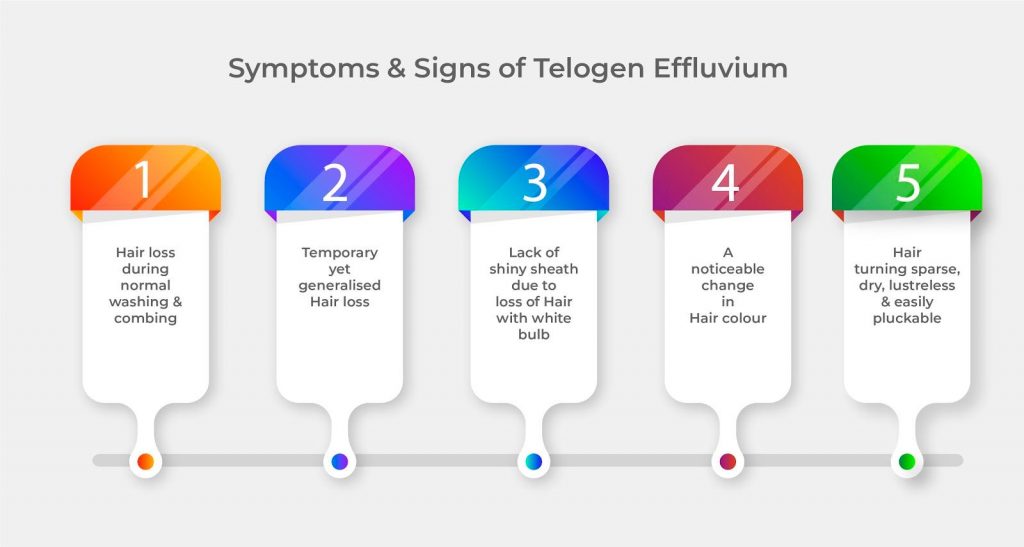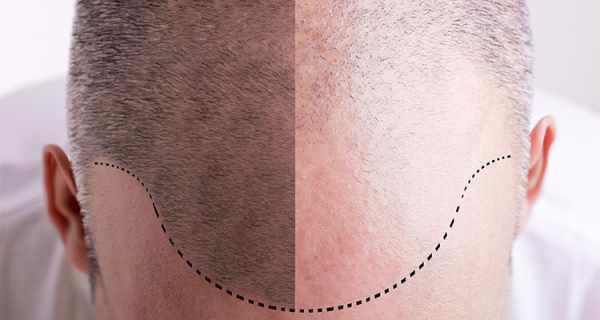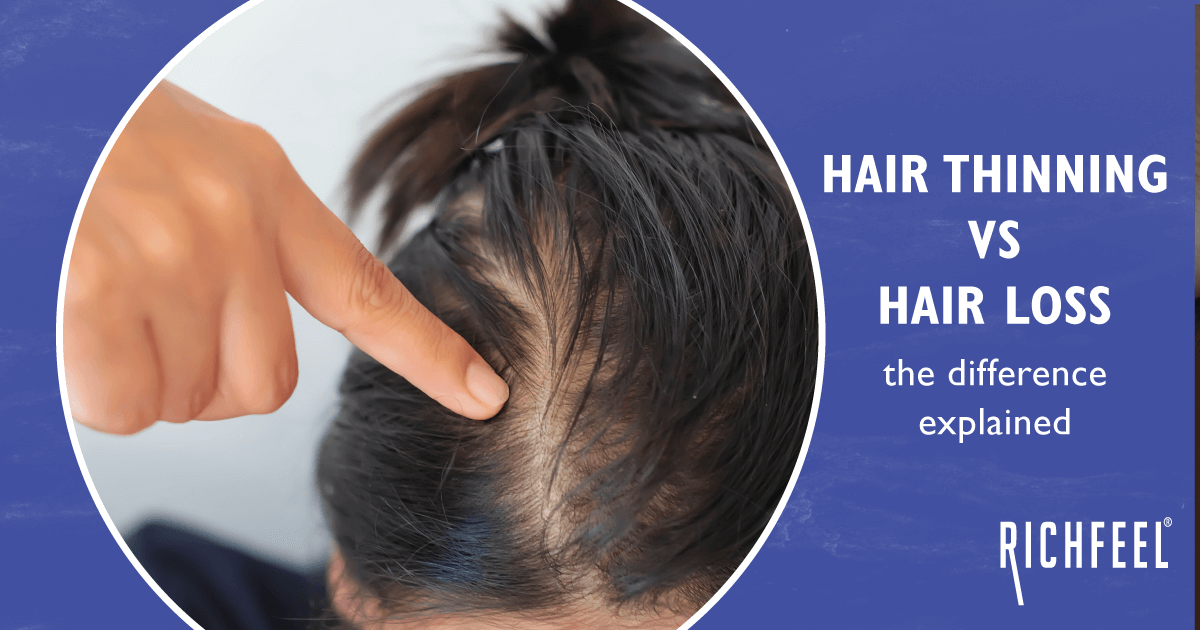The name sounds strange and intriguing? What if we told you that it is actually the most common hair loss problem in women! Yes.
You read that right. Telogen Effluvium is an extremely common form of temporary hair loss in women. The fact of the matter is that most are not aware of the condition, its symptoms and what needs to be done to reverse it. You simply term it ‘hair fall’ and proceed with the multitude of trials, changing oils, shampoos, hair wash regimes…
As we always say, when you know the root problem, you can treat it appropriately and control it in the long term. And with conditions such as this, professional expertise and intervention are much needed.
Let’s break this topic down in simple terms and help you understand what Telogen Effluvium is. But before we get to understanding the condition, there are some basic concepts that you need to understand. Starting with the hair cycle…
Hair Cycle – A simple overview
Ideally, on an average, humans have approximately 80,000 – 150,000 hair follicles on the scalp. The Hair follicle has a life cycle of its own with continuous growth and rest sequences. It is commonly referred to as the Hair growth cycle and it can be divided into phases called Anagen (growth phase), Catagen (transition phase) & Telogen (resting phase).
The duration that your hair strand stays in each of these growth and rest stages may depend on various endocrine, vascular and neural stimuli. It will further depend on where the hair strand is and factors such as age, gender and diet + lifestyle habits. As you grow older, the rate of hair growth and your hair density tends to decrease.
Ideally, 85-90% of your scalp hair is in the anagen stage, 1% in the catagen phase and 10-15% in the telogen phase. Anagen phase may last for about 2-6 years, catagen phase for about 2-3 weeks and telogen phase for about 3 months. This is only an approximation and differs from one person to the other as mentioned above., with several external factors impacting the cycle. To learn more about the hair cycle and what’s going on inside your hair strand, click here.
What is Diffuse Hair loss?
Anything that affects this normal hair cycle, can trigger diffuse hair loss. Diffuse hair loss or diffuse alopecia is a condition in which the individual’s hair density decreases across the breadth of the scalp. The primary trigger is always a disturbance to the hair growth cycle as mentioned. It can affect both genders, but it’s predominantly seen in women.
What is Telogen Effluvium (TE)?
Telogen Effluvium is a type of hair loss characterised by thinning and shedding of hair from the scalp. It appears as a diffuse hair loss mainly after the body has undergone severe stress and is often a temporary hair problem. While there is shedding & thinning of hair, the follicles are still intact and can start producting hair again (i.e. regrowth). It is thus a reversible condition, with due intervention. The time it takes to be reversed would depend on the severity of the condition.
The hair loss that happens when the hair is in the Telogen phase for prolonged duration is referred to as Telogen Effluvium. With this condition, the Anagen phase slows down, pushing lesser follicles into the next stage. And by this, approx. 30% of the hair follicles move into the Telogen phase. The condition may last upto 6 months and the individual can grow back the hair within a year. When the condition lasts for more than 6 months it is termed as Chronic Telogen Effluvium.
This condition can be triggered by multiple factors which we will look at in the upcoming section. The condition usually sets in typically about 3 months from the triggering event. It is characterised by a sudden onset of hair fall.
What are the causes and symptoms?

Some of the most common causes of TE are as below:
- Physiological stress
- Emotional stress
- Medical conditions such as thyroid disorder, PCOD, renal failure…
- Dietary imbalances, sudden excessive diet plan
- Hormonal changes – pregnancy, difficult labour, postpartum, menopause
- Drugs that can cause temporary hair loss as a side effect
- Excessive heat styling and over-styling
The prominent symptoms of Telogen Effluvium are multiple. Shedding of hair is the most common sign of Telogen Effluvium, however, the scalp remains healthy. You will notice a fair amount of hair loss on your pillow, during your shower and while combing. One tell-tale sign is that you will notice the hair shedding along with a white bulb at its root. This is how hair that’s in the Telogen phase looks like when pulled out. There is also overall dullness and in many cases, there is a change in hair colour from dark to brown or red, or brown to blond.
Telogen Effluvium does not cause bald patches on scalp unlike male and female pattern hair thinning. However, it results in an overall thinning of hair and diffuse hair loss.
When you visit a Trichologist, a detailed diagnosis is done. The medical history is discussed in detail, along with a talk on lifestyle and any possibly stressful events in the recent past. The doctor also checks the hair and scalp physically. Hair strands are taken as a sample to understand the A/T ratio of the hair growth cycle. Some of the common tests include the Hair pull test, Hair pluck test and the Wash test.
How do you treat it? Can it be prevented?
As mentioned above, in the case of TE, the hair follicles are intact. Which means that the condition can be corrected and hair regrown. It, however, needs professional advise and care. Typically, this condition is a sign of an underlying condition.
A consultation with a trichologist can throw light on the root trigger point. Establishing the root cause helps address the condition right. By adopting the right treatment the hair cycle can be normalised and hair will begin to grow back.
The treatment plan for TE includes,
- Reworking on (under physician guidance) catagen-inducing medication like beta-blockers, anticoagulants, or antithyroid agents
- Treatment of the underlying metabolic or hormonal disorder
- Supplements with iron, zinc, proteins, vitamins
- Diet rich in Hair foods that have ample iron, proteins, vitamins and minerals to support healthy hair growth.
- Topical application of minoxidil to promote hair growth is commonly advised. However, it has to be noted that this may cause an increased bout of hair shedding after stopping the application.
Telogen Effluvium resolves on its own once the Telogen hair falls and Anagen hair slowly starts growing. In about 6 to 8 months hair growth can be seen. With the correction of underlying causes, reduction of stress, a healthy diet, the condition can be resolved.
As regards prevention of TE, as you can see, many of the causes are life events that we go through and some are caused due to a multitude of other factors that may even be beyond our control. What would help is to generally attempt to have healthy hair. This would include having a regular proper hair care regime and ensuring a healthy diet. To list it out,
- Eating a healthy and balanced diet
- Drinking ample water
- Managing stress
- Getting enough sleep
- Switching medication that cause hair loss with the help of trichologist
- Reducing the intake of unhealthy food that increases body toxins
- Following a regular hair care regimen of oiling, shampooing, washing and conditioning
- Avoiding styling equipment and chemical hair products as much as possible.
Consult a professional trichologist in fixed intervals. This will help you spot any irregular signs and intervene appropriately when needed. Reversible hair loss can become irreversible when not addressed in a timely manner.
The Trichologist will guide you through the right diet and lifestyle that is best for you, suitable treatments, ensuring that you avoid concerns of hair loss. Trichologists perform a thorough study of your medical history, conduct a physical examination of your hair & scalp, diagnose through hair analysis using various methods and tech such as the FCT, capilloscopy, trichogram, hair pull test etc. , further examine the hair shaft, growth window and many more such key metrics. Periodic check-ups help keep a tab on your hair’s health and well being.
Being confronted with the problem of hair loss is not a choice, but providing a permanent solution for it is indeed a choice – your choice.
A reminder as always – for all things ‘Hair’, do follow our blogs on hair loss, hair care, treatments and solutions and such other interesting hair trivia!
Connect with us on social media on the links below. Do leave your questions & comments and we will address them all.



